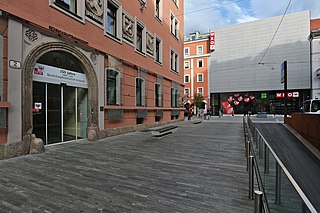
The Bezirk Innsbruck-Land is an administrative district (Bezirk) in Tyrol, Austria. It encloses the Statutarstadt Innsbruck, and borders Bavaria (Germany) in the north, the district Schwaz in the east, South Tyrol in Italy to the south, and the district of Imst in the west.

Franzensfeste is a comune and a village in South Tyrol in northern Italy. It is named after the large Franzensfeste Fortress erected from 1833 to 1838 and Franzensfeste station is also known as an important railway hub.

Brenner is a comune and a village in South Tyrol in northern Italy, located about 60 km (37 mi) north of Bolzano on the border with Tyrol, Austria.

Pfitsch is a comune (municipality) South Tyrol in northern Italy, located about 45 kilometres (28 mi) north of the city of Bolzano at the border with Austria. It is named after the valley of Pfitschtal or Pfitscher Tal.

Absam is a municipality in the Innsbruck-Land District, Tyrol (Austria) situated at an altitude of 632 m, which had an area of 51.92 km2 and 6,776 inhabitants as January 2015.

Aldrans is a municipality in the Innsbruck-Land District, Tyrol (Austria) at an altitude of 760 m (2,490 ft), which had an area of 8.89 km2 (3.43 sq mi) and 2,496 inhabitants as January 2015.

Ampass is a municipality in the Innsbruck-Land District, Tyrol (Austria) situated at an altitude of 651 m, has an area of 7.9 km2 and 1793 inhabitants as January 2015.
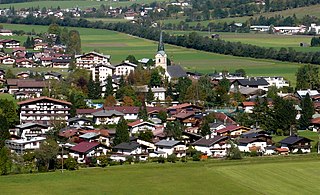
Kirchdorf in Tirol is a municipality in the Kitzbühel district in the Austrian state of Tyrol located 12.2 km (7.6 mi) north of Kitzbühel as well as 3 km (1.9 mi) north of Sankt Johann in Tirol at the Kitzbühler Ache. By area, Kirchdorf is the second largest municipality in the district. The village obtained its name from an old church which was built in the 8th century. The main sources of income are agriculture and tourism.

Tux is a municipality in the Schwaz district in the Austrian state of Tyrol.

Gries am Brenner, often referred to as simply Gries, is a municipality in the Wipptal in the southern district of Innsbruck-Land. The village consists of several hamlets.
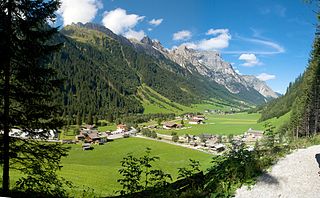
Gschnitz is a municipality with 415 inhabitants in the south of North Tyrol.
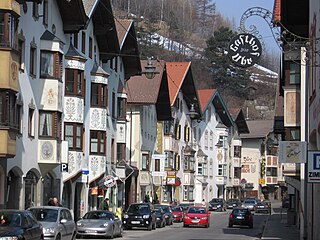
Matrei am Brenner is a small municipality in the southern part of the District Innsbruck-Land and is located approximately 17 km south of Innsbruck. Matrei has always been an important station for commerce. On 1 January 2022 the municipalities of Pfons and Mühlbachl were merged into Matrei. The village has 3,500 inhabitants, at 992 m. above sea level and the Sill river flows through it.

Mühlbachl was a municipality in the district Innsbruck-Land located 15 km south of Innsbruck. Mühlbachl extended from the southern slopes of Schönberg im Stubaital along Matreiwald to Steinach and the Sill River flew through it. It had 1,349 inhabitants. On 1 January 2022 Mühlbachl and Pfons were merged into the municipality of Matrei am Brenner.

Obernberg am Brenner is a municipality in the southern district of Innsbruck-Land in the Austrian state of Tirol.
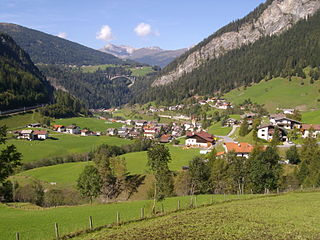
Vals is a municipality in the southern Innsbruck-Land District in the Austrian state of Tyrol.
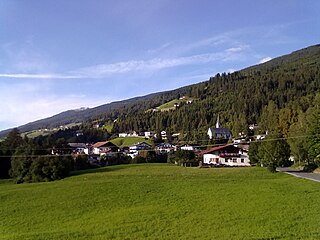
Pfons was a municipality in the district of Innsbruck-Land in the Austrian state of Tyrol located 13.7 km south of Innsbruck in the Wipptal at the Sill River. Although it is not exactly clear where the name of the village comes from, the location was first mentioned as “Phunzun” in 1030 and later as “Phanes” in 1177. Formerly a part of Matrei am Brenner, Pfons was declared as independent in 1811. On 1 January 2022 Pfons and Mühlbachl were merged into the municipality of Matrei am Brenner.

Schmirn is a municipality in the District Innsbruck-Land in the Austrian state of Tyrol.

Innsbruck Hauptbahnhof is the main railway station in Innsbruck, the capital city of the Austrian federal state of Tyrol. Opened in 1853, the station is a major hub for western and central Austria. In 2019, it was the 8th-busiest station in the country, and the 2nd-busiest outside of Vienna after only Linz Hauptbahnhof, with 315 train movements and 38,500 passengers daily.

The Tyrol S-Bahn, operated by ÖBB, provides regional rail services in metropolitan Innsbruck, Austria and its hinterlands in the state of Tyrol; and extended rail services into Italy and Germany.

Martin Knoller was an Austrian-Italian painter active in Italy who is remembered for his fresco work.


























